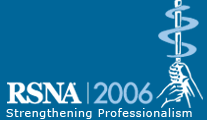
Abstract Archives of the RSNA, 2006
Saravanan Namasivayam MD, Presenter: Nothing to Disclose
Pardeep K Mittal MD, Abstract Co-Author: Nothing to Disclose
William Clark Small MD,PhD, Abstract Co-Author: Nothing to Disclose
Mannudeep Karanvirsingh Kalra MD, Abstract Co-Author: Research grant, General Electric Company
To determine number of “duplicate” images from overlapping scan volumes, and their diagnostic usefulness and additional radiation exposure with multi-region CT studies
Image datasets of 100 chest-abdomen CT examinations (age range, 28-78 years; M:F, 59:41), and 25 neck-chest CT examinations (age range, 22-72 years; M:F, 15:10) were reviewed to determine number of duplicate axial images from overlapping scan volumes. Chest-abdomen CT was performed with 120 kVp, 12 noise index, 0.5 second gantry rotation time. Scanning parameter for neck-chest CT were 120 kVp, 10 noise index, 0.5 second rotation time. Two radiologists evaluated duplicate images for CT findings. Mean tube current-time products were calculated for duplicate images.
Duplicate images were acquired in all (100%) chest-abdomen and neck-chest CT. A total of 4219 images were acquired in 125 CT studies, out of which 1513 images (36%, 1513/4219) had a duplicate set of images. Mean duplicate images were 26±3 and 19±2 per chest-abdomen and neck-chest CT, respectively. A total of 44 findings were noted in duplicate images of chest-abdomen, which were detected in both chest and abdomen datasets. A hypervascular hepatic lesion was seen in chest CT dataset only. Two patients had multiple hypovascular liver metastases, of which the smaller, sub-centimeter lesions were detected on abdomen CT dataset only. A total of 34 findings were noted in duplicate images of neck-chest CT. None of these were detected only in either neck or chest dataset. Mean tube current-time product was 162.5 and 208.7mAs for duplicate images of chest-abdomen, and neck-chest CT, respectively.
All multi-region CT studies have duplicate overlap region images. About 36% of multi-region CT images have duplicate set of images. Most findings on duplicate images are seen in either region dataset. Single volume helical acquisition for multi-region CT can result in substantial radiation dose reduction, while maintaining diagnostic accuracy.
single volume helical acquisition of multi-region scanning without overlap scanning can result in substantial radiation dose reduction, while maintaining the diagnostic accuracy.
Namasivayam, S,
Mittal, P,
Small, W,
Kalra, M,
Radiation Exposure and Diagnostic Usefulness of “Duplicate” CT Images. Radiological Society of North America 2006 Scientific Assembly and Annual Meeting, November 26 - December 1, 2006 ,Chicago IL.
http://archive.rsna.org/2006/4440829.html

